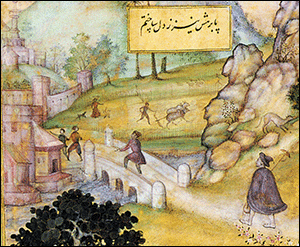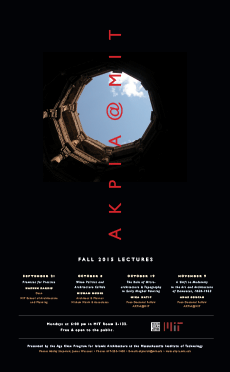Lectures, Conferences & Events» Past Lectures & Events
 Premises for Practice
Premises for Practice
Hashim Sarkis
Dean, MIT School of Architecture & Planning
Abstract
Through a presentation of recent projects designed by Hashim Sarkis Studios, the lecture focuses on recurring preoccupations and design strategies, upholding the architectural object in the face of change.
Biography
Hashim Sarkis was appointed Dean of the School of Architecture and Planning in January of 2015. Prior to that he was at Harvard University Graduate School of Design (GSD) as the The Aga Khan Professor of Landscape Architecture and Urbanism. In addition to professorships at Harvard University and MIT, Dean Sarkis has held numerous visiting appointments around the world including the American University of Beirut and the Metropolis Program in Barcelona.
In addition to his academic work, Dean Sarkis is principal architect in the Cambridge and Beirut based firm, HashimSarkis Studios, founded in 1998. His architectural and planning projects include affordable housing, institutional buildings, and town planning throughout the globe. His current projects include the Byblos Town Hall and the Courtowers, both under construction.
Dean Sarkis has received many awards and honors including the Venice Architecture Biennale, US Pavilion featuring Byblos Town Hall, Housing for the Fishermen of Tyre, and the Balloon Landing Park (June-November 2014); and First Prize Award for the Byblos Town Hall Competition, Byblos, Lebanon (2011). His work has been published in the Phaidon Atlas of 21st Century Architecture with the Housing for the Fishermen of Tyreselected as one of the most significant buildings of the 21st Century (2008). He also received numerous teaching awards while at Harvard University.
Sarkis is the author of many articles and books that have filled important gaps in the history of modern architecture and urban design. These include Circa 1958: Lebanon in the Pictures and Plans of Constantinos Doxiadis, and the edited books CASE: Le Corbusier’s Venice Hospital and Josep Lluis Sert: The Architect of Urban Design (with Eric Mumford).
Sarkis was a founding member of Plan B, Institute for Urban Design Studies in Lebanon and the Middle East and the Arab Center for Architecture. He has served on the board of several organizations including the Association for Rural Development in Southern Lebanon.He holds professional registration with the Beirut Order of Engineers and Architects.
Dean Sarkis has a Bachelor of Architecture and Bachelor of Fine Arts degree from Rhode Island School of Design and a Master of Architecture from Harvard University GSD. He received his Ph.D. in Architecture from Harvard University GSD for his thesis Publics and Architects: Re-Engaging Design in the Democracy.
When Politics and Architecture Collide (top)
Hisham Munir
Architect & Planner, Hisham Munir & Associates
Abstract
Throughout history Architecture and Politics have been intertwined. Leaders and Governments of all kinds want to make a mark and leave legacies for the next generations. Architecture is one of the perfect mediums for these expressions. The outcome can be brilliant or can be disastrous.
Iraq’s turbulent recent past over the last 50 years provided a colorful theater rich with dichotomy where these dynamics played out to extremes. In this lecture Mr. Hisham Munir, the pioneer of modern architecture in Iraq, will take us through a brief history of how some these dynamics played out during his illustrious career 1957 – 1994.
Biography
Hisham Munir is one of the leading architects in the Arab/Persian Gulf region. His firm, Munir Group Architects has wide range experience in providing comprehensive architectural, engineering and consulting services in the fields of: Health and Medical complexes (government and private health centers and hospitals), Cultural and Educational facilities (Schools Colleges and Universities), Government and Administrative complexes (Ministries and Departments), Professional Organizations Headquarters, Hotels (government and private), Airport Hangers, Banks, Housing and Urban Design. Mr. Munir and his firm have won the highest number of first prize awards in the competitions they participated. Published in numerous local and international publications. Experience of over forty years has covered all regions of Iraq, north, middle and south and the Arab/Persian Gulf. We have also successfully collaborated, associated and joint-ventures with various international firms: American, British, Brazilian, Canadian, Dutch, Italian and Swiss.

The Role of Micro-architecture and Topography in Early Mughal Painting (top)
Mika Natif
The George Washington University, AKPIA@MIT Post-Doctoral Fellow
Abstract
Since the 1580s, elaborate urban architecture and landscape scenes appeared in the background of Mughal paintings. Such representations consisted of India’s flora and fauna, genre scenes of local men and women working the land, and the depiction of cities. These miniature urban vignettes became so common that they are visible in numerous illustrations produced at the Mughal workshops under Emperor Akbar (r.1556-1605). Several scholars described these urban landscapes as a mélange of European and Mughal structures, and argued that Mughal artists borrowed this microarchitecture tradition from similar representations in the Christian Book of Hours. However, it appears that these mini-urban topographies portray settings that are linked to the Mughal world and not to Europe. The transformation/reconfiguration of the urban motifs into an Indian idiom altered their original Christian context and therefore reflects the Mughals’ sense of pride and ownership toward Hindustan, as well as their territorial identity.
Biography
Dr. Mika Natif (Ph.D., New York University – Institute of Fine Arts, 2006) is an art historian focusing on the intercultural exchanges and global connections that Muslim societies forged with the European sphere in the pre-Modern era. Her primary field of research is Islamic painting, with special interest in Mughal India, Central Asia and Iran. She is currently an Assistant Professor of Art History at The George Washington University, Washington, D.C. Previously, Mika had held teaching positions at Princeton University and at the College of the Holy Cross (MA), and curatorial positions at the Metropolitan Museum of Art, and most recently at the Harvard Art Museums (as Assistant Curator of Islamic and Later Indian Art). She has conducted research in archives, galleries and museums all over Europe, as well as Turkey, Israel, and India. Her publications include articles in peer-reviewed journals and book chapters on Islamic book arts, visual culture, idol anxiety, and objects of pilgrimage. Her current book manuscript, Mughal Occidentalism: Artistic Encounters Between Europe and Asia at the Courts of India, explores the transglobal styles and visual expressions that Mughal artists and patrons developed following the meeting of European art and Perso-Indian painting. She is also the co-editor and co-author of Eros and Sexuality in Islamic Art (Ashgate, September 2013).

A Shift to Modernity in the Art and Architecture of Damascus, 1860-1963 (top)
Anas Soufan
AKPIA@MIT Post-Doctoral Fellow
Abstract
Between the mid-19th century and the mid-20th century, embattled Islamic art in Syria has undergone a distinct shift abscribed to three main reasons: The change of political regimes, the European economic expansion in the region, and the emergence of the notion of making-heritage process - patrimonialisation. Muslims, non-Muslims, rulers, designers and administrators, were all interested in the renewed secular Islamic art and its agrandizing commemorative expressions. However, the dissimilarity of each groups sociopolitical ideologie contributed to disparate outcomes.
In the light of Oleg Grabar’s reflections on the definition of Islamic art as well as our investigations about the Syrian modernist debate and the built environment, this lecture deals with the change of the definition of Islamic art in Damascus during the Ottoman Reforms, the French Mandate and the postcolonial period. It emphasizes the predictability of this change, its initiators, its absolute and relative time, and its appropriation by the Syrian civil society on one side, the Ottoman, French and Syrian political regimes on the other. Three pertinent experiences will be employed in order to support the foregoing approaches: the reconstruction of Bāb Touma quarter after the events of 1860; the organization of al-Nasr Street since the early 20th century; and the reconstruction of Sidi-‘Amoud quarter after its bombarding and destruction in October 1925.
Biography
Anas, a Syrian artist and architect, founder of the Center of the History of Arab Modernity’s Studies in Paris, holds a bachelor and M.A from the Faculty of Architecture in the University of Damascus, a DEA in History from Université Paris I – Pantheon – Sorbonne, and a Ph.D in Art History from Ecole pratique des Hautes Etudes – Sorbonne. Since 2013, he has held a postdoctoral position at the University of Geneva
Anas scholarly interests include the history and historiography of architecture of Modernity in Syria during the 19th century until 1963, the Ottoman tanzimat, colonial and post-colonial criticism. In addition to several articles in Arabic, English, French, and Spanish, Anas first manuscript, a critic study related to the Ottoman and French administrative and legislative influences on the architectural mutations in Syria will be published in Paris in the end of 2015.
Among the lectures Anas gave in 2014 are: “Istanbul – Damascus: transcultural memory and architecture of Modernity prototyping”, Istanbul 29 Mayıs University, May, 2014; “Post-conflict urban and architectural reconstruction process: 1910-1950s Syrian Style as experimented historic case”, University of Southern Denmark, Odense, May, 2014; “Arab Nationalism in the emergence of the 1910-1950s Syrian Style”, University of Basel, Switzerland, September 2014.
In his work, Anas is attemptsto link his academic studies and his professional skills through international missions and programs; for instance, being an expert at UNESCO’s program concerning the preservation of the architecture of Modernity-s’ heritage in the Arab world as well as UNESCO’s project for the post-war reconstruction of Aleppo.
As a recipient of the AKPIA-MIT, Anas will draw on his expertise on the MENA architectural changes. Investigating the mutations of forms of appropriation of Islamic Art through the literature of Syrian reformists, politicians, religious and less famous intellectuals of the studied period. He focuses on one side, on the definition, predictability, time and span of Islamic Art renewal and on the other side, its place in the building of national artistic identity.
